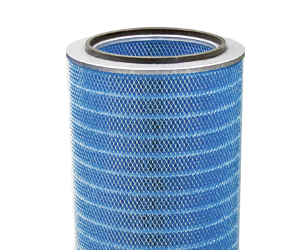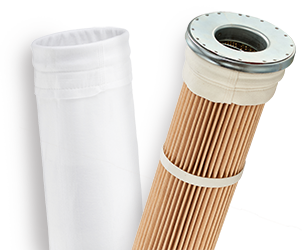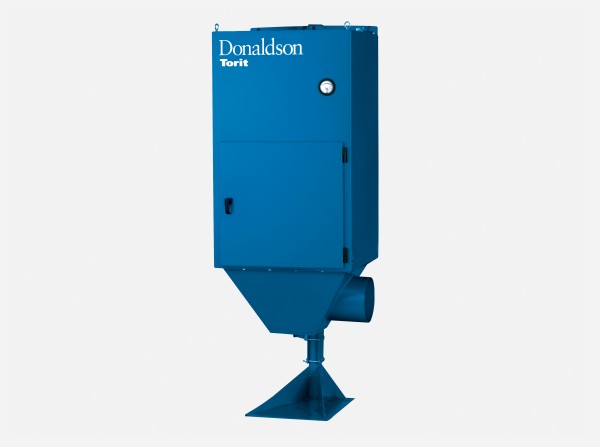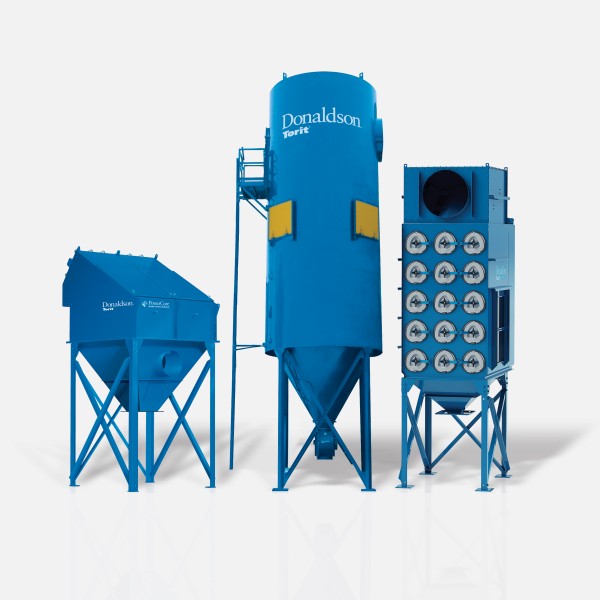Grinding
Grinding operations employ abrasive grains in various forms for the removal of material and metal to produce of different types of surface finishes. Abrasive grains held together with a hard, durable bonding material make grinding wheels, abrasive stones, and sticks. Abrasives can also be applied on fibrous sheets, paper, or cloth with the principle materials being aluminum oxide and silicon carbide. Crushed diamonds called Bort are also used as abrasive grains.
Common Applications
Sanding, tumbling, belt grinders, core grinders, horizontal double spindle disc grinders, vertical spindle disc grinders, jack grinders, portable grinders, small radial grinders, surface grinders, swing grinders, grinding benches, and grinding tables.
Feed Materials
Particulate from the object being finished including a variety of ferrous and non-ferrous metals such as aluminum, cast iron, steel, titanium as well as non-metals such as brake shoe, composites, and rubber.
Grinding Wheel Structure and Abrasives. The grinding wheel structure is the relative spacing of abrasive grains in a given volume of a grinding wheel and depends upon the abrasive grains, the bonding material, and the voids. A good structure will provide proper chip clearance so that as the abrasive grains cut chips out of the work the chips are thrown away from the face of the wheel. Wheels with a wide grain spacing are used generally when the contact area between work and wheel is large, material being ground is soft, or when rapid removal is required. Narrower grain structures are generally suitable when fine finishes are required or when contact area is small and the material being ground is hard.
Grinding Wheel Bonds are the materials that hold the abrasive grains together. It is the amount of bond used that determines the “hardness” or “softness” of the wheel. The heavier the coating of bond around the abrasive the harder the wheel is rated. Grinding wheel bonds are of six general types:
- Vitrified: Seventy-five percent of the grinding wheels manufactured has this type of bond. These wheels are porous, free cutting, and unaffected by water, acids, oils, heat, or cold.
- Silicate: These wheels release their abrasive grain readily making them relatively mild acting. Best used where heat must be kept to a minimum such as in grinding edge tools.
- Shellac: These wheels can produce high finishes on work such as camshaft and steel rolls. They are also used for grinding cutlery and for thin-cut wheels. They are not suited for heavy-duty grinding.
- Rubber: Rubber wheels are used as feed wheels on centerless grinding machines. They are used for producing high finishes on ball bearing races for cut-off wheels where minimum burr is important as well as snagging wheels where a high-quality finish is required, such as on stainless steel bullets and welds. Rubber bond lends itself to making strong wheels 0.8 mm / 1/32 in. thick and less.
- Resinoid: Resinoid wheels are used in foundries, welding shops and billot shops for high speed rough grinding. The stock removal rate is generally in direct proportion to the speed of the wheel. These wheels can be operated at speeds as high as 9500 rpm.
- Magnesite (Magnesium Oxychloride): This bond is used in wheels and segments for certain types of disc grinding.
Dust Characteristics
A combination of coating materials, metallic particulate, and grinding wheel abrasives and wheel bond agents are all generated during the grinding process. The dust will likely be abrasive, possibly agglomerative, and may often pose a potential fire and explosion risk.
Notes
Due to the variety of work and types of grinding machines employed, it is necessary to develop hoods adaptable to the machine in question, and such hoods should be located as close as possible to the operation. Do not mix ferrous and non-ferrous metals in the same exhaust system. Consult applicable NFPA codes.
Buffing and Polishing
Buffing — The objective of buffing is to make a rough surface smooth; however, every part does not have the same finish and will need to be worked differently. Buffing can be divided by three categories. They are defined as satin finishing, cut-down buffing for preliminary smoothness, and cut and color buffing for smoothness and luster.
- Satin Finishing: Produces satin, brushed, or “butler” (highly polished) finishes on metals. Satin finishes are produced by first buffing the work piece to a bright finish and then dulling it to give it a softer, brushed look. These finishes are applied using an abrasive and glue mix or greaseless compounds.
- Color Buffing: Refines the surface and brings out maximum luster. The work piece is moved toward the direction of the wheel using medium to light pressure.
- Cut Down Buffing: Makes surfaces smoother by removing scratches and other marks caused by previous operations. The work piece should be moved against the direction of the wheel using a medium to hard pressure.
Polishing — Polishing is not a precision operation. It is used to remove metal and produce fine-scale abrasion. Friction generates high temperatures that can soften the surface of the work piece. Polishing, which usually involves several stages, proceeds buffing.
Common Applications
Manual buffing and polishing, buffing lathe, backstand idler polishing machine, straight line automatic buffing, circular automatic buffing, and metal polishing belt.
Feed Materials
Buffing Wheels or Buffs are created from cotton, canvas, chamois, sisal, or string. They may be loose, sewn ventilated, or pocketed. Buffing wheels have a variety of designs and run at speeds of 5000-6000 rpm. They have safe and unsafe areas of operation and care should always be taken when working around them. Several types of buffs are described here.
- Loose Buffs have several plies of material with a row of sewing around the center hole. These buffs are most often used for the final buffing operation prior to plating. Because the wheel is not tightly stitched, it will collapse allowing cotton to get into awkward places more easily. The best loose buffs are 100% cotton.
- Sewn Buffs have sections of cloth sewn in a crescent pattern that runs from the center of the buff to the edge. These buffs are usually used for buffing non-ferrous metals. They can also be used as coloring buffs. The wheel is harder, and more pressure can be applied. This is useful when cutting metal.
- Bias Type Buffs are probably used most often in the industry. The cloth is cut at a 45° angle, wrapped around a drum and squeezed into a clinch ring. These buffs combine flexibility and cutting power. Spacing between the sections provides for natural ventilation and can be easily customized to work with various sized parts.
- Folded Buffs have disks of material folded to form pockets that hold compound. They are mounted in one direction for cutting and mounted the other way for coloring.
- Sisal Buffs are the most aggressive of the buffs producing polishing and cutting action and are most used on ferrous metal applications. Sisal buffs soften and become flexible from the heat generated during the buffing operation.
- String Buffs are soft and flexible for use on plastics or precious metals to avoid leaving buff marks. These buffs are also good for coloring precious metals since they leave no buff marks. They can have up to 100 layers of cloth or plies and come on soft, medium, or hard densities.
Buffing Compounds do the work. Compounds are applied to the buff prior to the work. The work is used to force the compound into the buff, speeding buffing time. Compounds are composed of fine, abrasive materials such as aluminum oxide, emery, silicon carbide, diamond, boron carbide, and zirconium. These are bonded together by grease, oil, or various types of waxes and are referred to as “Tripoli” compounds.
- Chrome Rouges are used for buffing, chromium, and stainless steel. These rouges are made of mild oils and greases with alumina abrasives.
- Jewelers Rouge. Red rouge brings out a high color on gold, silver, sterling, platinum, and brass. White rouge produces a brilliant finish on chromium, stainless steel, steel, brass, and aluminum. Green rouge is used for fine color buffing on all types of metal.
- Liquid Buffing Compounds are used with automatic machines in high-volume production situations. Spray guns are used to apply liquid compound pumped from a drum. The same abrasive powders are used in spray compounds; however, the binders are different. Binders are used in oil solutions or water emulsions so that they are fluid at room temperature.
- Polishing Wheels are made of muslin, canvas, wool, or leather. The most common of which are made from sections of sewn cotton held together with adhesives. Most polishing operation speeds range from 5000-7500 rpm. Polishing wheels that are more flexible are better for polishing of irregular surfaces.
Dust Characteristics
Contaminate from these operations can present itself in many forms, such as long fibrous stringers, agglomerated masses of cotton or fibers mixed with waxes or oil and abrasives. The abrasives can be generated from the wheels or the piece being worked. Particulate can or may be flammable or explosive and caution should be used when dealing with such.














